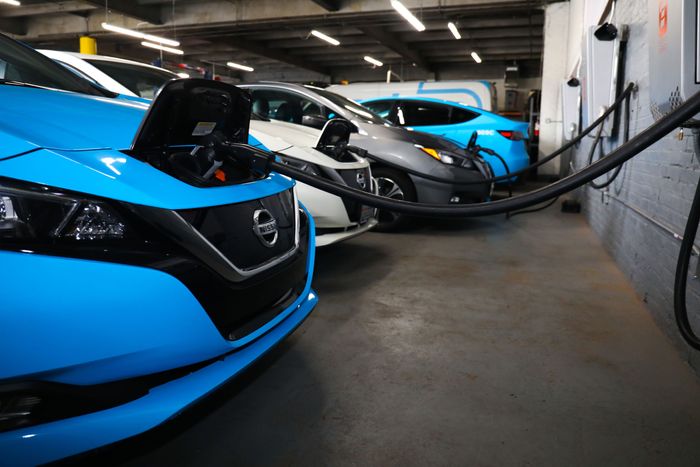Can a Garage Full of Revel Taxis Stop the Next Blackout?

Sweltering summer days put tremendous pressure on New York City’s web of substations and transmission lines, where a failure can quickly devolve from small inconvenience to major catastrophe. A partial solution may soon be sitting in the city’s parking structures. The batteries of electric cars, charged during off-hours, can feed their juice back into the grid when it’s really needed. It would take some infrastructural modifications to make it happen, but treating the city’s garaged cars as a bank of batteries, may, in the future, really make a difference right when demand peaks around dinnertime, as people come home from work, run dishwashers, do laundry, and crank up the AC.
This week, the EV ridesharing company Revel took the first small steps toward this future by installing three bidirectional chargers in its Red Hook hub. It’s the first place in the city to deploy vehicle-to-grid, or V2G, technology, meaning cars charged here can both slurp up power and dump it back out. This flexibility not only increases capacity; it also could eventually eliminate the customary move of firing up a coal-powered plant for backup, which is why Revel received program funding from Con Edison. “These distributed resources can someday work to replace peaker plants that sit on standby all year long,” says David Arfin, CEO and co-founder of NineDot Energy, the project’s clean-energy developer. “They’re expensive to maintain and operate just for those few times they’re needed on a summer weekday.”
Revel’s rideshare Teslas aren’t capable of V2G charging (yet), so for the time being the company is using Nissan Leafs to test the concept. Arfin’s team will be watching how well the hardware and software, by a company called Fermata, can monitor the flow of watts to make sure efficiency is maximized, then tracking it from the other end to see how effectively Con Edison can put the power to work. The idea is that eventually more of Revel’s chargers, including those in its public-charging hubs, could be swapped out for bidirectional ones, transforming its vehicles into a roving microgrid. The possibilities really become exciting when imagining how the technology could work at scale — like using all of Amazon’s delivery vans for grid storage or harnessing the battery power of New York’s massive municipal fleet.
In El Cajon, California, the ideal case just launched last month: Eight electric school buses are beginning to test how V2G could work at large scale. School buses are the perfect candidate for bidirectional charging, because most of them are driven only twice a day; they can reliably charge overnight when demand is low and also, in California’s case, even draw directly from on-site solar panels during the sunniest hours. As San Diego schools add more V2G capacity, San Diego Gas & Electric will pay the school district for returning energy to the grid, meaning the chargers also become a new revenue-generating tool.
NineDot Energy, which is a project of NYU’s Urban Future Lab, is working on launching V2G pilots like this in all five boroughs, recently installing a community battery-storage site under a solar carport in the Bronx. The city needs to move toward distributed energy storage for two pressing reasons: The city’s plans to decarbonize means New York will rely more on offshore wind, which is mostly being supplied at night and will therefore require more daytime storage, and a guaranteed increase in electricity demand is on the horizon, not only owing to increased adoption of EVs but also thanks to other clean-energy interventions like electric heat pumps. The trick, Arfin says, is working closely with utilities to find out where and when that grid support is needed in order to keep the lights on. “You have all these mobile batteries, all day, every day, in the New York City market. Sometimes they’re moving, sometimes they’re parked,” he says. “But can they deliver energy to the grid when it’s needed the most?”

